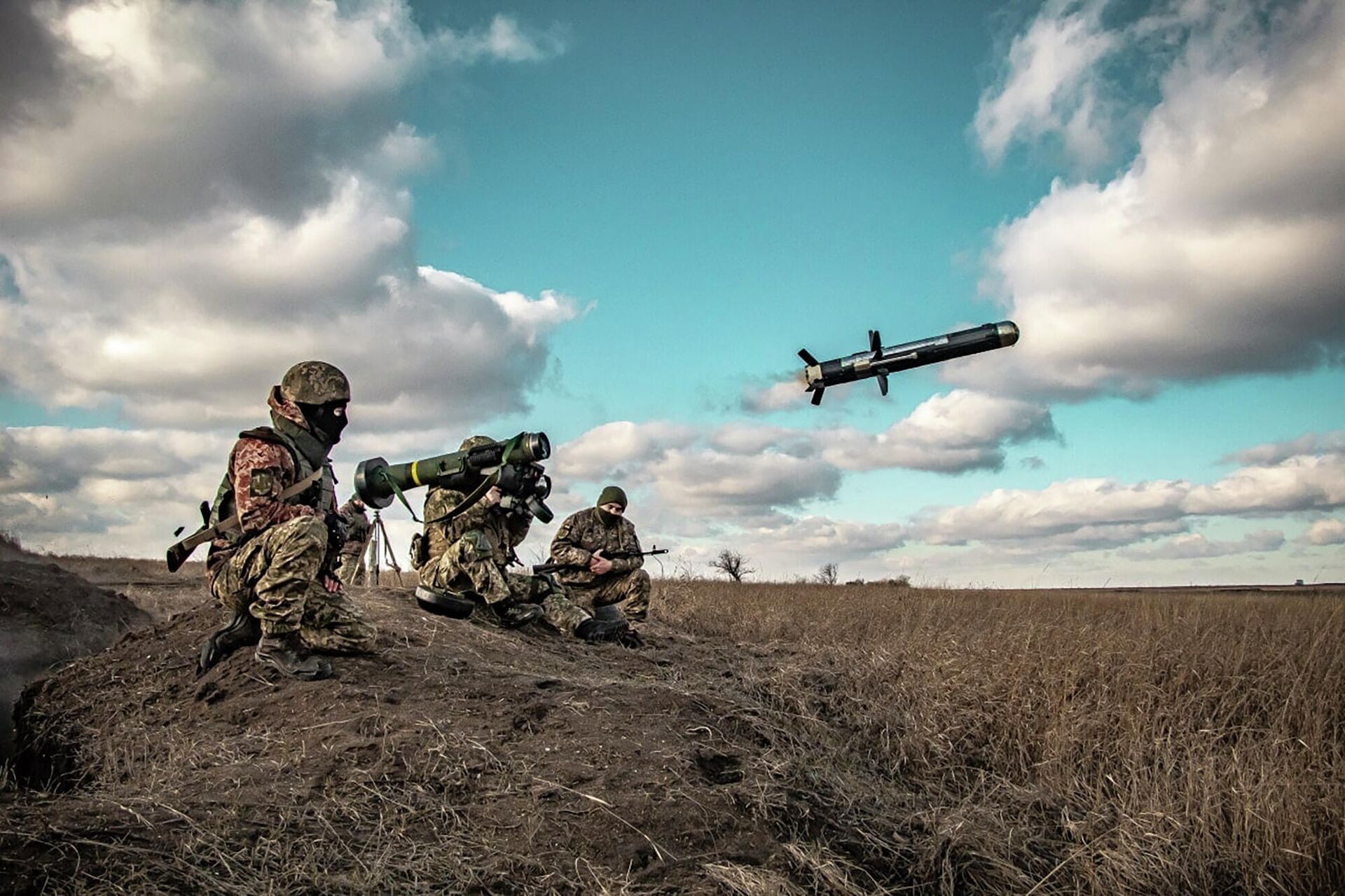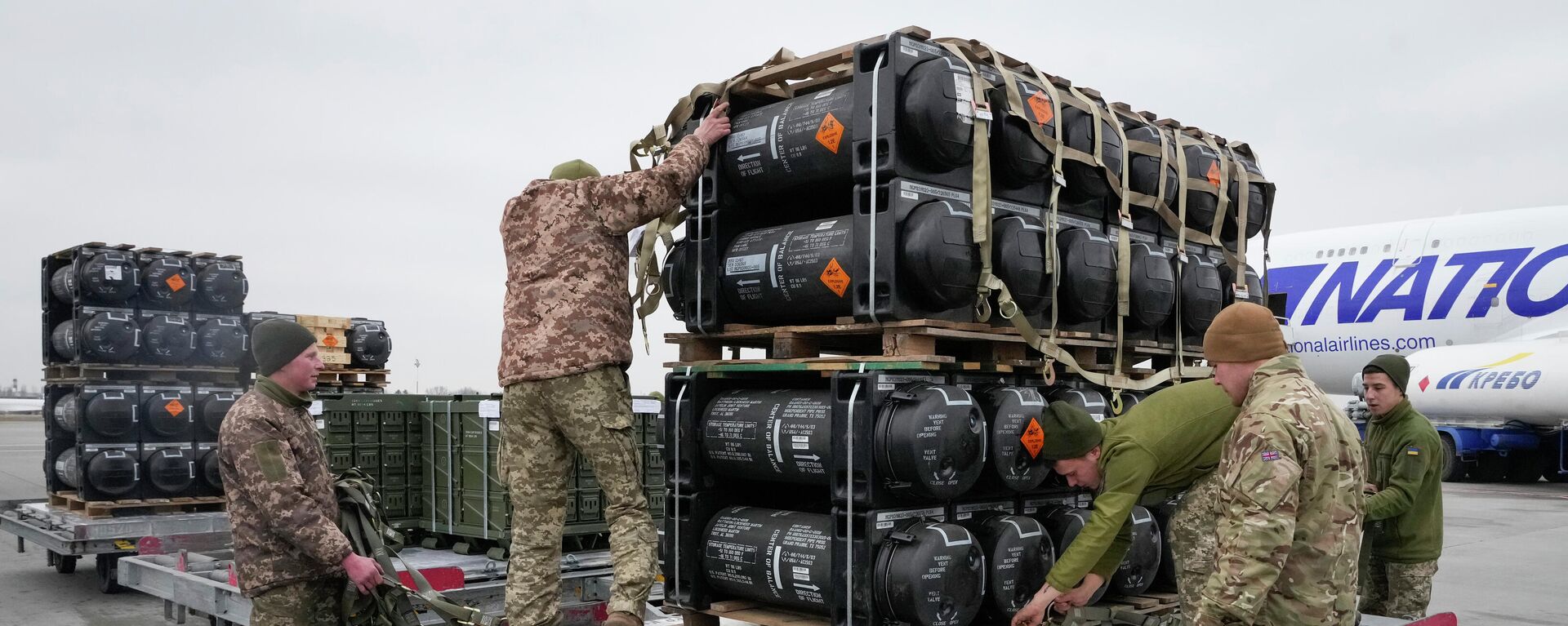US Weapons Sent to Ukraine Are Destroyed by Russia or End Up in Black Markets, Ex-Official Says

© AFP 2023 / JUNG YEON-JE
Subscribe
Washington has provided $3.4 billion in weapons to Ukraine since the beginning of the Russian special operation. This includes the latest $800 million package encompassing 72 howitzer systems, 144,000 shells and tactical drones among other military assets. Still, the US doesn't really know what happens to weapons sent to Ukraine, according to CNN.
During the 26 April meeting with NATO foreign military leaders at Ramstein Air Base, Defense Secretary Lloyd Austin pledged to move “heaven and earth” to provide more weapons to the Ukrainian Armed Forces. Earlier, on 21 April, Joe Biden announced another $800 million in military aid for Ukraine, which marked the eighth instalment of military aid sent to Kiev from the US.
Just days before Biden and Austin's announcements, CNN published an article eloquently titled "What happens to weapons sent to Ukraine? The US doesn't really know." The media outlet quoted US officials and Pentagon sources as saying that "the US has few ways to track the substantial supply of anti-tank, anti-aircraft and other weaponry it has sent across the border into Ukraine."
"We have fidelity for a short time, but when it enters the fog of war, we have almost zero," a source familiar with the matter told CNN. "It drops into a big black hole, and you have almost no sense of it at all after a short period of time."
According to US officials, the risk is that in the long term, "some of those weapons may wind up in the hands of other militaries and militias that the US did not intend to arm." For its part, Ukraine "has an incentive to give only information that will bolster their case for more aid, more arms and more diplomatic assistance," they say.
Nevertheless US officials insist that "a failure to adequately arm Ukraine [is] a greater risk" than billions worth of weapons ending up in the wrong hands.
One of Europe’s Largest Arms Trafficking Markets
The apparently controversial stance of US officials comes as no surprise if one recalls large stockpiles of arms left by Washington in Afghanistan, and frantic airdropping of weapons in Syria under Barack Obama, according to Dr Paul Craig Roberts, US economist, ex-assistant secretary of the treasury under Ronald Reagan and former member of the Cold War Committee on the Present Danger.
"The weapons left in Afghanistan were supposed to equip the Afghan government forces against the Taliban*," Dr Roberts says, adding that US weapons that ended up in the hands of Syrian jihadists, including Daesh**, were in fact intended for these terrorists in order to topple Syrian President Bashar al-Assad.
When it comes to Ukraine, lots of foreign weapons are being destroyed by the Russian military, he notes, suggesting that "any not destroyed are sold to enrich the Ukrainian officials who can control the weapons". Therefore, large caches of weapons don't even reach the battlefield, according to the former Reagan official.
Remarkably, prior to the latest conflict, Ukraine was dubbed by the Global Organised Crime Index "one of Europe’s largest arms trafficking markets," wrote Taylor Giorno from the Quincy Institute in her op-ed for Responsible Statecraft in March. She noted that Ukrainian "civilians and soldiers alike" used to funnel weapons "into an expansive illicit weapons trafficking network".
"Although Ukraine ramped up investigations into the theft of military property in 2014, diversion of small and major arms persisted," Giorno wrote. "A Small Arms Survey briefing on illicit arms flows in 2017, for example, found that, of the more than 300,000 small arms that disappeared from Ukraine from 2013 to 2015, only about 13 percent were ever recovered… Theft and diversion are not confined to small arms or civilian thieves. In 2019, for example, two Ukrainian soldiers attempted to sell 40 RGD-5 grenades, 15 RPG-22 rockets, and 2,454 firearms cartridges for a mere 75,000 Ukrainian hryvnia (approximately $2,900)."

In this image released by the Ukrainian Defence Ministry Press Service, Ukrainian soldiers use a launcher with US Javelin missiles during military exercises in the Donetsk Region, Thursday, Dec. 23, 2021.
© AP Photo / Ukrainian Defense Ministry Press Service
Jacobin, a left-leaning US magazine, notes, commenting on CNN's April article, that this is not the first time that US defence officials and security experts have voiced concerns that foreign arms sent to Ukraine might end up in the wrong hands. This raises the question of Washington's genuine intentions, according to the magazine.
"Is the purpose of the arms shipments to strengthen Ukraine’s hand in reaching a negotiated settlement to the conflict — a process from which the Biden administration and allied governments have so far held themselves aloof?" Jacobin's Branko Marcetic asks. "Or is it, as some US and British officials have suggested, to turn Ukraine into an Afghanistan-like quagmire for Russia, weakening it and perhaps even triggering regime change, while sending a message to China in the process?"
Dr. Roberts regards these suggestions as unrealistic. "As the Ukrainian forces are surrounded, there is no way for the weapons to get through the Russian lines," he says. "Even if weapons got through, the Ukrainian military is no longer capable of offensive action."

The U.S. Capitol building is seen before sunrise on Capitol Hill in Washington, Monday, March. 21, 2022.
© AP Photo / Gemunu Amarasinghe
GOP and Dems' Money Waste
Meanwhile, the US Republicans are willingly supporting the Biden administration's armament spree even though they previously subjected the Democrats' infrastructure packages to scrutiny and blocked spending bills over inflation fears.
"Thirty-one Senate Republicans voted last week against the $1.5 trillion spending bill to fund the government, increase US defence spending and provide humanitarian and military assistance to Ukraine," the Washington Post reported on 17 March. "In recent days, many of them have clamoured for more weapons and aid."
The crux of the matter is that "the US military security complex is a huge contributor to political campaigns," according to Dr. Roberts. "It doesn't pay politicians to complain about military spending," the economist says.
While inflation keeps soaring and US national debt is going through the roof, the Democrats and Republicans are ready to spend billions on weapons vanishing in the "fog of war" in Ukraine.
"The US National Debt is $30 trillion. US Household Debt is $17 trillion. Then there are state and local government debts. Considering the massive debt load, $3.4 billion is invisible," the economist concludes.
*The Taliban is an organisation under UN sanctions for terrorist activities.
** Daesh (ISIS/ISIL) is a terrorist organisation banned in Russia and many other countries.


